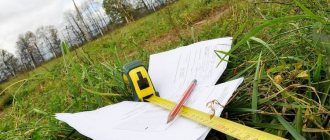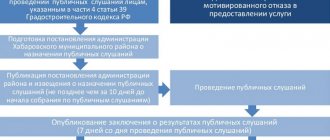When can land be seized?
Seizure of property is carried out only in cases specified by law. And since it is an interim measure, the decision to impose it is made by the court.
Seizure of a land plot by court decision is made during the trial to identify the owner of the plot. If there is a reasonable fear that the disputed land will be alienated before the end of the court case.
If we are talking about a procedure concerning the debtor’s property, this type of punishment is used in the following cases:
- seizure of a land plot by a bailiff can be imposed as an enforcement action to ensure the execution of a document, for example, in cases of alimony or loan repayment;
- Property may be seized if a person has a tax debt. This is how tax and customs officials ensure the repayment of debt on taxes and fines. However, for this, the tax service must obtain the sanction of the prosecutor (clause 1 of article 77).
Reasons for overlap
Seizure is a restriction of the right to freely dispose of property.
Simply put, the plot on which it was imposed cannot be sold, donated or otherwise disposed of. From this we can conclude that such a measure is applied because a person has some kind of debt, other unfulfilled obligations or a dispute - usually a judicial one. Also, the reason for the arrest may be claims made by the injured party in a civil suit within the framework of criminal proceedings. Arrest as a restrictive measure can be applied at the initiative of various authorities, as follows:
- The bailiff service imposes a restriction on alienation as an interim measure. If the debt is not repaid by other means, the plot is sold at auction or transferred to the debtor;
- the court seizes the plot if there is a dispute about the right, as well as if there is a debt corresponding to the value of the plot, as part of the case for debt collection, when it is impossible to ensure the fulfillment of obligations in other ways;
- The Federal Tax Service uses this measure if there is a significant tax debt.
These bodies facilitate the use of interim measures and justify their position in a resolution, which is transmitted to Rosreestr.
The reason for imposing an encumbrance is the presence of a dispute or debt. The plot can serve as a source of repayment of obligations, so the possibility of its implementation will be “frozen”.
Who seizes land plots
Seizure of a land plot can only be carried out by a strictly defined circle of government bodies. Since the measure significantly limits the rights of the owner, it requires serious consideration.
The primary right to seize property is assigned to the court. The procedure can only be carried out on the basis of a court decision.
If you have any doubts about whether other persons can seize a land plot, you should refer to the Tax Code. It stipulates that both tax officers and customs officers are capable of initiating an arrest.
The actual implementation of the ban is most often entrusted to bailiffs.
When not superimposed
An arrest always causes additional difficulties. The owner is deprived of the opportunity to use the plot belonging to him in accordance with his own will, for example, to sell it, donate it or exchange it. The absence of debts and disputes will help to avoid arrest, but this does not always depend on the owner himself.
Some plots of land are not subject to seizure at all. For example, if there is a house on the land that is the debtor’s only home.
Seizure is imposed only when there is no other property that can serve as a source of debt compensation. If the debt amounts to several tens of thousands of rubles, and the debtor owns a car, then a seizure of the vehicle will be sufficient to ensure the rights of the creditor; the request to seize the property will be rejected.
Under what conditions can a land plot not be seized?
A plot of land may not always become the object of seizure. The legislator has identified special circumstances that exclude the use of such a measure. The listed conditions are intended to protect the constitutional right of a citizen to housing.
Thus, plots on which a building is erected, which is the only place suitable for the debtor to live, are not subject to seizure.
There is one caveat: this building should not be mortgaged. This means that the land plot on which the mortgaged house stands may be seized due to the debt under the mortgage agreement.
Practical features
At first glance, removing the interim measure seems simple. It is necessary to eliminate the cause of the imposition and file a corresponding application. But is this how it works in practice? In general, yes, but you need to take into account some features :
- withdrawal can only be carried out at the request of the interested person. Most often this is the owner of the site;
- The application must describe in detail the reason why the restriction should be lifted. As a rule, this is the repayment of a debt or the end of a dispute;
- if the initiator of the arrest was a party to the legal proceedings, then the procedural party must submit an application to remove it. And if it was initiated by another person, for example, a new buyer of the plot, then the case will be considered in a lawsuit. The defendants will be other interested parties, for example, other creditors, because of the debt to whom the debt was imposed.
The court will require evidence to show why the restriction should be lifted.
How to release a land plot from seizure
No one is interested in having the “arrested” status permanently preserved in real estate documents. However, both the imposition and removal of arrest must follow the rules. At the same time, the conditions for lifting restrictions depend on the reasons for applying the penalty.
| Reason for arrest | How to remove an arrest |
| A debt collected by a bailiff as part of enforcement proceedings to pay off debt for alimony, mortgage, and so on. | Pay off a debt under an obligation: pay a loan, alimony. |
| Debt to the tax or customs services: taxes, penalties, fines. | Pay off tax debt by paying taxes, penalties and interest. |
| Dispute over ownership of seized land. | Obtain a court decision in the case of identifying the owner of the plot. |
Where can you check a site for arrest?
Restrictions on land transactions are available to owners in the Unified State Register. In it, you can easily issue a certificate on the object of interest - this opportunity is provided so that buyers can check the presence of a prohibition regarding the subject of the agreement. Such a certificate will cost 400 rubles . for individuals or 1200 rubles . for organizations.
But the extract may not contain the latest relevant information: judges and the FSSP inform Rosreestr about the arrest, after which the data is sent to the Unified State Register. To be vigilant, it is worth looking at the information on the websites of the district court about claims against the owner of the land plot that made the decision on the case, and visiting the local department of the FSPP itself.
How to lift an arrest: features of the procedure
Removing the seizure of a land plot begins with filing an application with the judicial authority. To save time and money, you need to consider a number of conditions:
- The appeal is issued in the form of a statement of claim.
- The claim is filed by the owner-debtor, other shared owners of the plot or representatives by notarized power of attorney.
- The application contains the basis for lifting the arrest: confirmation of repayment of the debt, and so on.
- The requirement is supported by evidence:
- certificate of ownership;
- court decision on arrest (determination - if there was an arrest of the land plot by court decision, by a bailiff’s decision);
- debt payment receipts and other documents.
- The consideration of the case is accompanied by the payment of a state fee. Its size is determined by the cadastral value of the site.
- The statement of claim and attached documents are submitted to the court in person or by registered mail with acknowledgment of receipt.
The court decision that has entered into force is transferred to the authorized body. As a rule, this body is (FSSP). No more than 3 days later, the FSSP is obliged to send a copy of the document on the lifting of the arrest to Rosreestr.
Step-by-step instruction
It will be possible to independently remove the interim measure only through the court. The application must contain the following information:
- details of the court to which it is filed, as well as details of the parties to the original dispute;
- claim price. It can be determined by the value of the site (estimated, cadastral or inventory);
- information about the imposition: the authority that imposed it, the date, as well as the circumstances under which it was implemented;
- reasons why the restriction should be lifted;
- list of applications.
Legal assistance in preparing an application >>
At the end of the application there is a date and signature. If it is submitted by a representative, then this fact is noted.
The application must be accompanied by a receipt for payment of the fee, documents for the site, a decision on imposition and other documents justifying the applicant’s position.
The court will summon the defendant and third parties and hear their positions. If, for example, the debt has already been repaid in full, then the arrest will certainly be lifted, just as in the final settlement of the dispute. The parties may also enter into a settlement agreement providing for the removal of the restriction in exchange for other guarantees. If it does not violate the rights of third parties, then the court cannot refuse satisfaction.
Removal of seizure from a willed land plot
In some cases, the arrested plot of the debtor is the object of inheritance. At the same time, until the receipt of the documents, the heirs may not have any idea about the features of the future property. And then the question of how to remove the seizure imposed by the court from the land plot will face them especially acutely.
Lifting the seizure begins with receiving an extract from the Unified State Register of Real Estate (USRN) with information about who seized the land and on what basis.
Then you need to write a statement of claim to the court for the release of property from seizure. After its consideration, a court decision will be made based on the established circumstances.
Where to find out information about the arrest
If a person has any doubts about any encumbrances on the land, he is recommended to contact the authorized body, which is called Rosreestr.
The owner or his representative, empowered on the basis of a notarized power of attorney, comes in person to the territorial office of the specified government body. There he orders an extract from the real estate register. The document will reflect all information about restrictions and encumbrances, including arrest.
If the owner of the plot does not know where to turn, you can find the nearest branch of Rosreestr on the official website of the authority, having previously indicated the city or region of location.
Checking the existence of a lien on a land plot
Before signing an agreement regarding real estate, you should clearly understand the legal status of the object: whether there are any encumbrances on it.
You can check the seizure of land by contacting the authorized body - (Rosreestr).
Rosreestr, guided by the Unified State Register of Real Estate. It contains information about objects, including arrest data.
Information is available in an extract from the Unified State Register of Taxes, which can be obtained no more than 3 business days after submitting the request:
- at the Rosreestr office;
- in the Multifunctional Center (MFC);
- online;
- through on-site service.
To do this you need to submit:
- statement;
- identification document of the applicant;
- other documents, for example, a certificate of inheritance.
Receiving an extract is a paid service. Its cost depends on the completeness of the information and starts from 300 rubles.
Depending on the method of submitting the application, the applicant will receive a document on paper or an electronic certificate certified by a digital signature.
If you are interested in how to check the seizure of a land plot online, use a special service on the Rosreestr website “Obtaining USRN information.” To do this you need:
- Go to the main page of the Rosreestr website.
- Click on “Receive information from the Unified State Register of Real Estate”.
- Fill out the request by entering:
- object data;
- your passport details;
- additional information and scanned copies of documents.
- Check the entered information.
- Send a request.
After this, the applicant will receive the requested document.
General information is also available by the cadastral number of the land plot, which is contained in the Public Cadastral Map.
If the debtor is an organization
If an organization acts as a debtor, then the defendant in court will be its representative or representatives who will defend the interests of the organization. In addition, only property (including land) that is owned by the organization will be subject to recovery. So, if it has a debt that the organization cannot pay off on its own or does not do so for some other reason, then the land plot is seized, and then the land is sold at the highest profit.
In cases where an organization can offer other property for search and collection, then it is this property that is subject to sale, provided that the proceeds from the sale of this property are sufficient to pay off the debt. The right to ownership of the land plot in this case remains with the organization.
If during the trial new circumstances related to the use of a land plot are discovered, for example, its use is not for its intended purpose or in violation of the law, then the organization may be held liable for violations, obligated to eliminate them, or recover the land plot for subsequent sale according to its original intended purpose.
A claimant who has filed a claim against an organization has the right to protect his interests by all legal means.
And the proceeds from the organization’s property are subject to immediate payment to the victim.
To file a claim against an organization, a clear procedure has been established:
- drawing up a statement indicating all the circumstances;
- demand for recovery of land from an organization to pay for debt or compensation for damage;
- participation in judicial debates;
- submission of evidence to the court and indication of the grounds for recovery of land or other property.
So, for example, in judicial practice there are cases when the owner of a land plot (an individual) leases a plot of land to an organization. The latter uses it for other purposes, as a result of which it violates both the law and the terms of the lease agreement.
In this case, in addition to recovering the land plot back to the owner, the organization is usually issued either a fine in monetary equivalent as compensation for the damage caused, or an order is issued to eliminate the damage in kind, for example, by bringing the land into proper condition.
What operations can be carried out with the seized area?
Let's say your property is seized. Either the plot you would like to buy is burdened with this status, or, even worse, you have discovered a seizure of the developer’s land under an equity participation agreement. In such situations, you will probably want to find out whether any transactions can be carried out with such property, and in what cases the law allows actions with such a site.
After a decision is made to seize a land plot, the owner can no longer freely dispose of it: donate it, bequeath it, or sell it.
This means that a transaction for the sale of land under arrest will be impossible, because the sale and purchase agreement simply will not be registered.
A debtor who wants to sell a seized plot before it is auctioned off by the bailiffs has two options:
- Remove the arrest by eliminating the causes of its occurrence. For example, to pay off debts under a writ of execution and so on. After this, he will again acquire the right to make transactions with property.
- Find a buyer, notify him of the arrest, and only after that enter into a preliminary purchase and sale agreement with him under the condition that the owner undertakes to take measures to lift the arrest. Under such an agreement, you can receive a deposit from the buyer. With the money received through this option, you can pay off the debts that caused the arrest.
In addition, it is possible to divide the plot during arrest in the case of shared property.
If the debtor is one of the spouses, and a seizure is imposed on a land plot belonging to the entire family, the bailiff is obliged to allocate the debtor's share from the common property by filing an application with the court.
The judicial authority will make a decision on the basis of which the second spouse will be able to register separate ownership of half of the land.
Seizure procedure
The measure is applied after the initiation of enforcement proceedings. The bailiff is obliged to make a decision and invite two witnesses to the proceedings. The procedure itself is formalized through an act (clause 5 of Article 80 No. 229-FZ), which contains the following information:
- details of citizens who participate in drawing up the act;
- information about the object or right that is subject to seizure. The data must be sufficient to identify the object;
- preliminary cost estimate;
- duration and scope of restrictions;
- information about the seizure of the item, if it was carried out;
- information about the responsible custodian.
The document must also state that the custodian's legal rights and responsibilities are explained to him. There is also room for the expression of opinions and disagreements of those involved in the procedure.
The document must be signed not only by the bailiff himself, but also by other citizens who participated in its preparation.
Afterwards, the bailiff draws up a decree, copies of which are sent to the parties, as well as to the place of execution, for example, to a bank or registration authority, depending on what property is subject to restriction.
Seizure of funds
The procedure and features of seizure of financial assets are determined in Article 81 No. 229-FZ. The bailiff makes a decision and sends it to the financial institution in which the person has an account or deposit.
However, information about the availability of relevant accounts is not always known to the specialist in advance. In this case, he sends applications to banks and other organizations to search for accounts and seize the amount of the claim.
The bailiff's request must be implemented immediately. A financial organization does not have the right to refuse the FSSP to take an interim measure. The removal of the arrest from the account is carried out immediately, after the relevant act of the bailiff is issued.
Seizure of securities
The rules for applying appropriate measures to securities are regulated by Article 82 No. 229-FZ. The procedure is carried out at the location of these values.
When implementing the measure, the bailiff issues a resolution and also draws up an act according to the rules established in Article 80 No. 229-FZ. The document indicates the number of papers, the type and information about the persons by whom they were issued.
The adoption of such an interim measure means that the person will not be able to sell or transfer the securities, as well as dispose of them in other ways. But other restrictions, including the right to receive income, although they can be applied, must be justified in the resolution.






